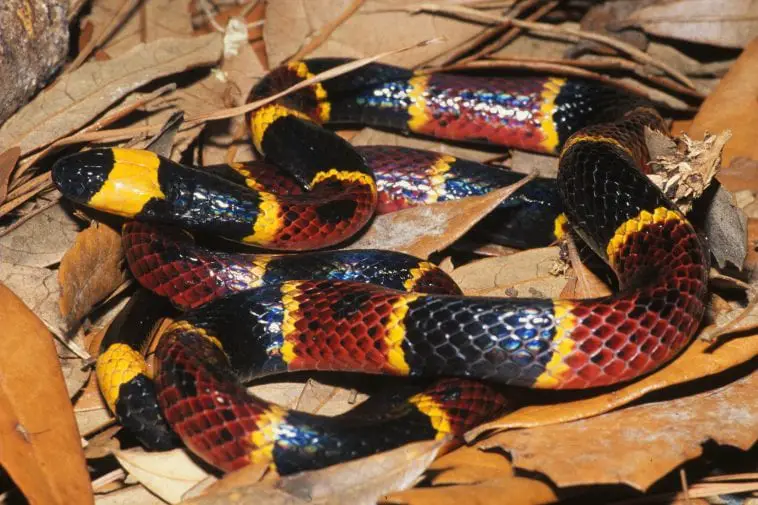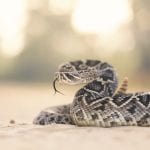Scientific Description
| Common Name | Eastern Coral Snake, Common Coral Snake, American Cobra |
| Scientific Name | Micrurus fulvius |
| Life Span | Average of 7 years in captivity |
| Size | 30 to 48 inches |
| Habitat | Tropical and sub-tropical forests, Flatwoods, oak forests, creek sides, and riverbeds, sandy areas |
| Country of Origin | Southeast United States |
| Conservation Status | Least Concern |
Physical Description
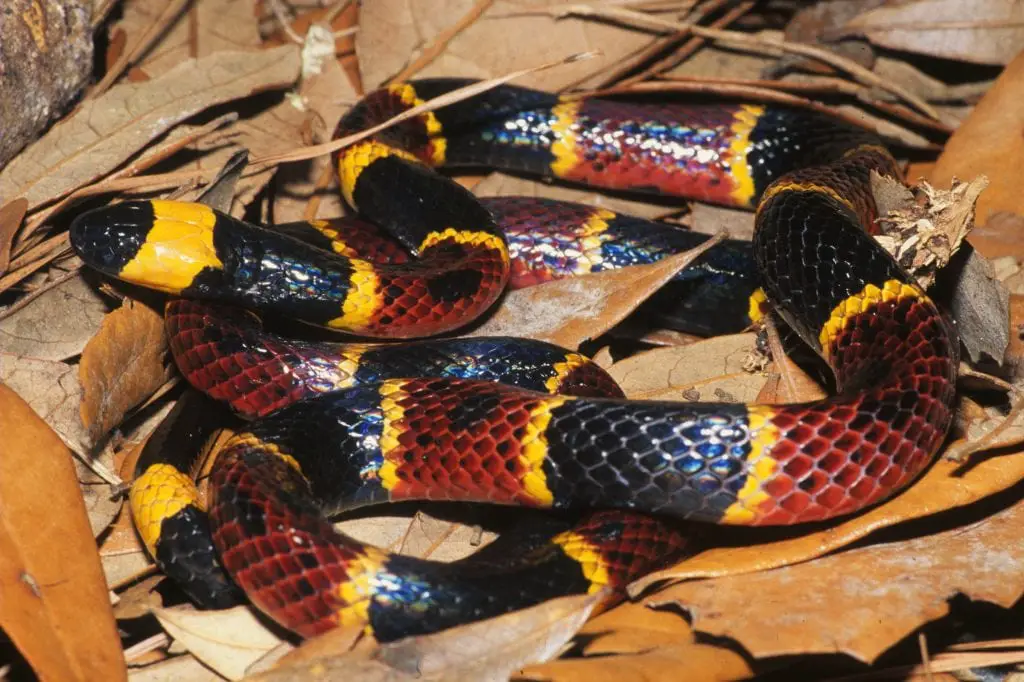
The Eastern Coral Snake is one of the three endemic coral snakes to be found in the United States of America, particularly to the Southeast Portion of the country, beginning from Alabama up to the Atlantic coast of North Carolina.
This snake is medium-sized and slender, primarily characterized by colorful wide bands of black and red, separated equally with narrow yellow rings, that perfectly blend on its natural habitat in the forests of Southeast US. Their venom is regarded as one of the deadliest in the world, matching the power of King Cobra, and the other vipers, capable of killing its prey, including the human intruders in a matter of minutes.
Males are known to have longer tails, showing their sexual maturity, but the female coral snakes are known to grow longer than males, despite their shorter tails, compared to the males.
Types
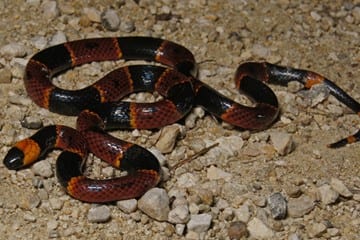
Unfortunately, there are no subspecies falling under its kind, considering that the Eastern Coral Snake is already subspecies of the coral snakes in the United States. They are directly connected with the other Coral Snakes of the American lands, with the same following classifications:
| Kingdom | Animalia |
| Phylum | Chordata |
| Class | Reptilia |
| Order | Squamata |
| Suborder | Serpentes |
| Family | Elapidae |
| Genus | Micrurus |
Despite their similarities with the other Coral Snakes of the same country, they still have the differences that make them unique from one another, among which is the geographical setting where they live, making up their entire behaviors. The Southeast United States is known to be a swampy area, as it faces the Caribbean and Atlantic Seas.
Life Span
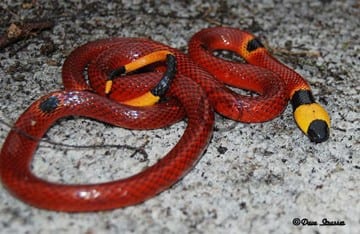
The Eastern Coral Snakes have a very secretive life, puzzling out the researchers on how do they live their lives in the wilderness, beginning from their birth. Because of the lack of information about this species, one can earn some important information with the other venomous snakes of the world.
The Reptilian Eggs
Snakes come from eggs. However, one must know that not all snakes lay eggs at all. Some snakes carry the eggs inside their body for two to three months, before giving birth to them. Mother Eastern Coral Snakes have this character of laying off her eggs and make them live independently. As soon as the baby snakes start to hatch, they already carry the venom that their parents have. This feature makes them more hazardous than the adult snakes, as they cannot control their venom when they bite another creature or a human which causes serious harm and may lead to an untimely death.
To be a neonate is the worst stage of a snake’s life, considering that it is abandoned by its mother, the other siblings may get eaten by bigger predators, and the remaining baby snake has to live alone by its own- far from the help of anything and anyone. Their length usually ranges from 6 to 7 inches during their hatching period.
The new hatchlings have no food to eat aside from the yolk that came from their eggs or the embryonic sac of their mother’s womb. This fluid is important for them as it is filled with important minerals that can help them to survive for days, considering that they can’t eat preys yet in the expected time.
Young Snakes
Minutes after its birth, a baby Coral Snake should start living alone. During this point in time, young snakes train themselves on how to prey on their food. The wilderness is full of uncertainties- it is either the snake who should kill to live, or it will be killed for others to live. They may have the ability to move faster than the mature snakes, but the younger ones are still more susceptible to greater hazards as they are not fully developed to live independently.
Aware of these possible causes, the baby snakes are the fastest and most defensive reptiles in the world, becoming fearful or shy from bigger creatures, yet they are the worst defensive creeping reptile if the need arises. Remember that these tiny and somewhat cute creatures are deadly as hell because of the venom embedded in their young fangs.
On the other hand, they can already kill small predators such as rats, small birds, other reptiles, and other small creatures as well. It is in this stage that an Eastern Coral Snake develops its nature of feeding on meats, thus called carnivores.
One of the remarkable features of young Coral Snakes ns their molting process which takes place for twice of four times a year, depending on the weather and the speed of a snake’s growth. The good thing with the Eastern Coral Snakes is their body built, helping them to shed faster and easier than the other snakes living in the United States.
Adulthood
It is in this stage that all snakes develop all of their survival skills, mastering the way of life, adapting to the ever-changing climate and weather, and the art of reproduction.
Adult Eastern Coral Snakes are known to surprise their preys and attack only once through stealthy moves. With this coordinated action, Coral Snakes effectively kill their targets not only with their fang but with their deadly venom as well.
Learning from their past experiences, adult Coral snakes have higher chances of living longer and just eventually die because of age. However, modern science still doesn’t know how long do they live in the wilderness.
It is in this stage that they move further to humans and live deeply in the wilderness, far from human intervention.
Eating Habits
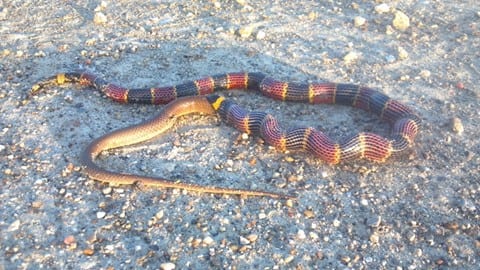
Eastern Coral Snakes are known to be carnivorous and prefer to kill their prey with the power of their venom and swift move. In a matter of seconds, a rodent can be caught off-guard by a hungry adult snake. Apart from their deadly venom, Eastern Coral Snakes also kill their preys through squeezing, especially that they too can form the infamous ball position, just like the pythons when eating their preys.
Their favorite appetizers are rodents such as rats and other creepers, smaller reptiles, even the younger snakes, lizards, rabbits, squirrels, and to extreme cases, small birds at the nest.
During their younger years, baby Coral Snakes are known to devour on insects and small rats. As it matures year after year, these venomous species become opportunistic and aim to eat bigger preys within the list of possible food choices, to the extent that they target animals bigger than them, including the other snakes with the same venomous power.
Sleeping Habits
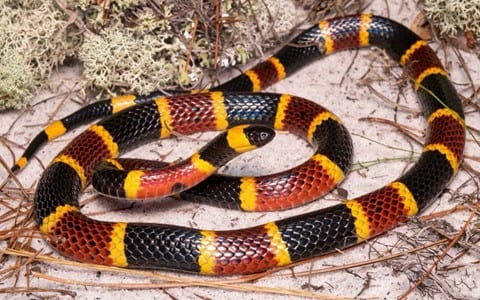
Because Eastern Coral Snakes are diurnal animals, they are widely awake in the morning and sleeps at night.
They have similar sleeping habits and patterns compared with the other existing snakes. Most of the snakes have a circadian rhythm that generally describes their behavior when they sleep. Just like us humans, they follow a regular cycle on when to wake up and when to prepare to sleep. On average, their sleeping pattern comes in waves lasting for 10 hours a day or more. It dramatically increases during the days that it has to digest its prey.
However, their geographical setting affects the time that they should take some rest. For those who live in the winter regions of North America, an Easter Coral Snake seeks shelter in the deepest parts of accessible holes or caves and keep them coiled all throughout the season and starts to take its brumation (a reptilian dormancy which is similar to other animals’ hibernation) to save its energy and avoid dying during the harsh weather condition where the food source is badly scarce and almost next to none.
For the Coral snakes living in the desert and arid areas of Texas up to the Cowboy Southwest, the snakes seldom awake in search for food and are relatively active when the days are hot, despite the body clock that tells them to take the brumation cycle.
Behavior
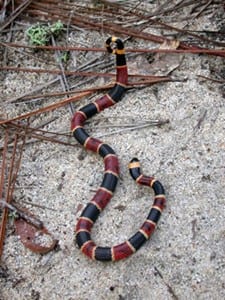
The Eastern Coral Snakes use their color bands wisely, giving an obvious warning to their surroundings of the venomous power that they have. In defense, they use their body frame with equally distributed colors to confuse their predators on which end of their body should be bitten first to avoid their venom.
During the breeding season, the male snakes become more aggressive in finding for their female partners, especially when a competition happens among the males. The same procedure of competition happens to them, compared with the other venomous snakes in the wild.
Little are known about Eastern Coral Snakes, putting them in the greater spotlight of scientific studies, improved by the growing curiosity of various animal research centers of the world. This secrecy has given a substantial broken link to their identity. Up to this day, numerous studies are being carried out intentionally designed for them.
As the old rhyme goes, Red and yellow, kill a fellow; red and black, a friend of Jack. Indeed, this rhyme gives a warning to anyone who attempts to touch an Eastern Coral Snake while in the wild.
Legality as a Pet
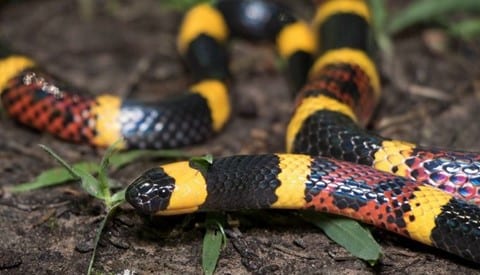
The IUCN has classified the Eastern Coral Snakes as one of the Least Concerned Animals in the wild, as their studies show that the population of this snake is still stable. However, there are Federal and State Laws to understand if one really wants to own an Eastern Coral Snake, especially the safety procedures that they should follow to avoid any serious health concerns.
Health Conditions
One of the downsides of their secretive lives is the failure to check for any possible illnesses that an Eastern Coral Snake may receive in the wild, as well as in captivity. They may show some signs of them feeling sick, just like the other snakes being kept as pets.
- Loss of Appetite
- Weight Loss
- Reduction in Daily Activities (but not during the Hibernation/Brumation Period)
Preventing Illnesses
To avoid the unprecedented illnesses that can develop within an Eastern Coral Snake, an owner must keep the following rules implemented:
Cage
An Eastern Coral Snake demands a big cage directly proportion with their maximum length. It must not live with another snake inside a cage as this will surely mean death for one of them. Remember that they are very territorial and loves to live alone between rocky shelters or crevices.
Water
Just like us humans, Eastern Coral Snakes need water for hydration and regulation of body temperature. Looking on their scaly skins, one can say that a snake will not produce its own sweat. With this, they will rely on water for cooling down and body system regulations.
Temperature and Humidity
Eastern Coral Snakes are scattered across the North and South America, living as hellish as on top of a snowy mountain or under the scorching heat of the sun in the deserts. However, as they try to survive for a lifetime, they must keep their ideal body temperature to function well, especially that they are generally slow yet stealthy in nature.
Nutrition
Eastern Coral Snakes are carnivorous and do not eat any vegetation at all, even in desperate cases. Because of this, one is highly advised that he or she must be knowledgeable about what kind of animals do Coral Snakes eat. One must avoid giving any rodents from uncertain sources, which can harbor diseases to the snakes themselves.
Unfortunately, rats in the urban setting can’t be simply eaten by Eastern Coral Snakes anymore, considering the nature where they live, what they eat and how do they live daily in the sewerage systems under the cities.
Hibernation
All snakes living in the United States are subject to the annual brumation cycle or the reptilian equivalence of an animal’s hibernation.
Brumation is caused by the ectothermic condition of the reptiles or simply being cold-blooded animals. Eastern Coral Snakes are no excuse of that condition, and because of this, they heavily rely on the environment to successfully regulate their body temperature and manage to live longer. During this time, coral snakes are lethargic and mildly stops in doing any daily activities to save their body in sustaining colder temperature which is hard to eradicate in the middle of a winter season. However, there are Eastern Coral Snakes that are reported to stop in brumating for a while during the hotter days included in this cycle, allowing them to eat properly and go back to rest for another period of weeks or months.
During captivity, there are reports that snake owners try to stop the cycle by simply adjusting the room temperature in the terrarium and keep the snakes awake. However, it is highly recommended to let the snakes continue practicing this important biological cycle to keep the snake healthy and live for a longer period. Altering this cycle may have a bad impact on their health, thus leading to serious and chronic conditions.
Shedding
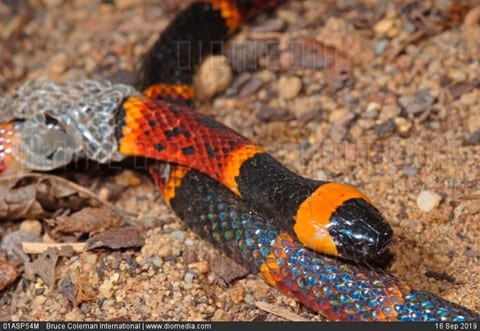
Just like the other snakes, Eastern Coral Snakes need the room for their physiological growth over the years, despite their significantly smaller sizes, compared to the other venomous snakes of the Americas.
The process of shedding off their skin is called molting or ecdysis, where a reptile changes its former skin with a better one that can give more space for the said reptile to grow. Ecdysis happens because of the inelastic property of a reptile’s skin, stopping it from growing bigger for the future years. Because of this restricted feature, most of the reptiles existing in the world are required to molt their skin to continue growing bigger from its previous molting process.
Though ecdysis is not well studied with the Eastern Coral Snakes, one can assume that it happens more often with the younger snakes compared with the fully matured adults that have reached the limit of their growth.
One cannot predict when will the molting process may take place. However, the first hint of an upcoming molting time can be seen with the color of your snake’s eyes. When it starts to turn to a blueish white (far from dark green), and its skin looks dull, chances are that the shedding will happen days from the time you have spotted these hints from your snake.
For the Coral Snakes, it is an important thing to keep its cage with enough humidity and availability of lukewarm water in the cage. It would be a great help for the snake if its owner can provide a moist shedding box for the rattler. This box should be filled with damp paper towels to encourage the snake shed on that spot where humidity is optimal and of great volume to make the process more successful. In the absence of an improvised shedding box, one can simply add a basin with warm water to make the process faster to complete, while making your snake healthy and safe in the entire process.
It will be also helpful if one can spray in the terrarium to increase humidity levels.
The last thing to do is to add rough materials inside the terrarium which can help your snake in rubbing off its flaky skin. Twigs, tree barks, stones, and other coarse materials can help your coral snake finish its business in shedding its skin.
To complete the process, you may visit your vet to check the condition of your rattler after it finishes its molting process
Habitat
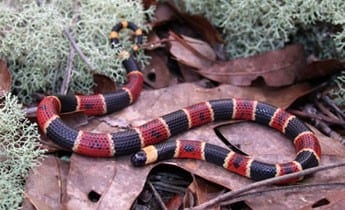
Eastern Coral Snakes live in various settings of the Southeast United States, but predominantly, they exist in swampy, marshy, Flatwoods, and even sandy areas of the place. The availability of their food in the said areas has forced them to settle in such kinds of terrain and keep their watchful senses with their targets to help them live longer and keep their bodies healthy for the wild.
With the said conditions, one must prepare to have a terrarium with the perfect setup, imitating a Southeast American forest, covered with plants and twigs, as well as sandy or rocky bedding to let your snake feel that they actually live inside a part of the wilderness.
Lighting and Humidity
Eastern Coral Snakes love humidity and warmth. This makes them be considered as diurnal animals, actively moving in the daytime with their attempts to receive enough amounts of sunlight. However, in captivity, it is not required for the owner to add some hot lamps to recreate this natural setup for them. Instead, an under tank heater is more advised for them and be placed on one side of the terrarium.
For the humidity, one should place a water bowl inside its terrarium, far from the hot side of the tank to keep its humid conditions be kept from the ideal range the same with the other snakes living in Southeast US.
Temperature
The ideal temperature for the Eastern Coral Snakes ranges from 70 to 82 degrees Fahrenheit or 21 to 27 degrees Celsius. The terrarium for the Coral Snakes must have a two-sided temperature, the hotter side should have its peak of 82 degrees, while the other side must be colder with 70 to 75 degrees. At night, the general temperature for the Eastern Corals must be of 65 to 68 degrees Fahrenheit or 18 to 20 degrees Celsius.
Tank Bedding and Accessories
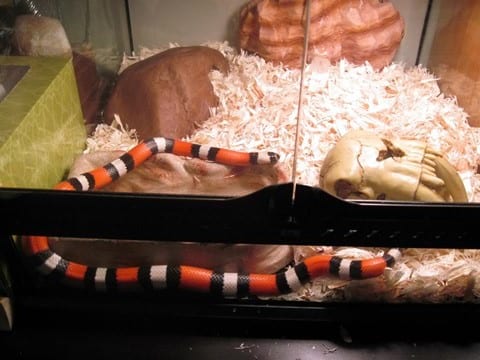
The tank bedding must be of inches thick and made up of peat moss, cypress mulch or pelleted newspaper that will serve as its burrow during its stay inside the cage. Make the rest of the cage floor dry and the burrow site with the only moisture that will favor the snake and dig deeper beneath. To complete the wonderful cage for Eastern Coral Snakes, include some rocks and branches, with little vegetation for the tank’s humidity and thermal regulation.
Avoid over decorating to give way for the Eastern Coral Snake’s movements and allow it to roam freely without any obstruction that may harm its skin.
Sanitation
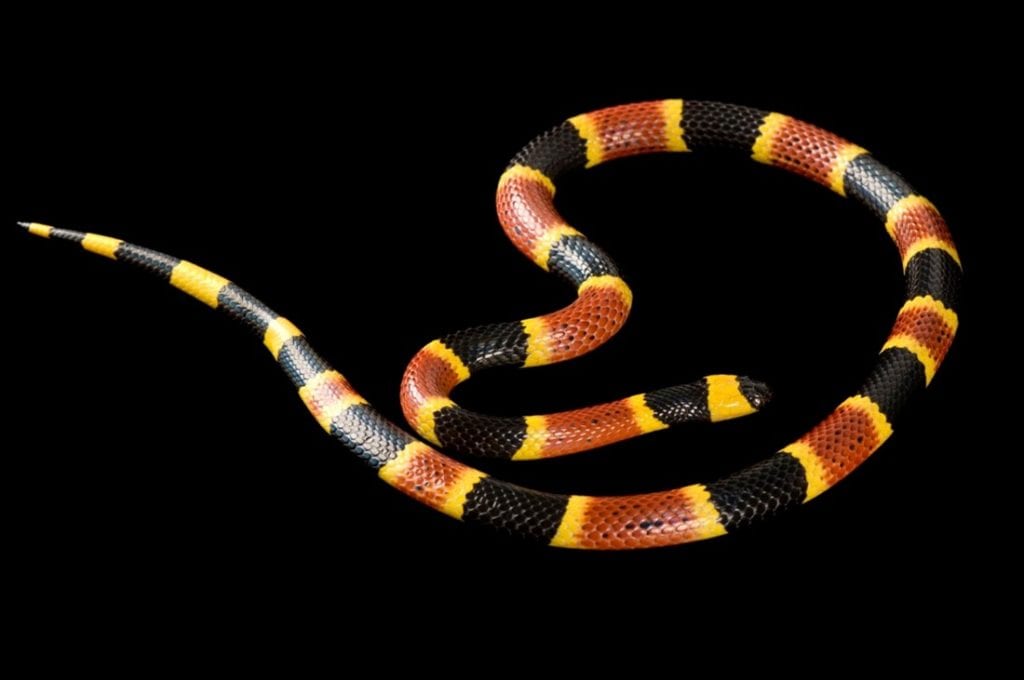
As much as possible, keep the cage clean by gently transferring first your pet to another container as you carefully disassemble the materials set up inside the cage. Remove the fecal deposits of your snake inside the cage and fix the materials that might have been damaged by the coral snake as it moves over the surface at times.
Avoid putting plants with strong odors, which may affect the sense of smell of your coral snake. Apart from it, the odor that plants emit will confuse the snake, preventing it to eat your delivered prey.
Availability- Where to Get One?
Eastern Coral Snakes, despite its venomous condition, is still popular among the reptile owners and lovers. They are available with the licensed pet shops in the US, especially in the states where their population are big and stable. Avoid buying the snakes with referrals as this may put you in danger of violating your State Laws.
How to Take Care of It
The rule of thumb in taking good care of the Eastern Coral Snakes is to keep the least human intervention with the snake- especially in terms of physical touch. These animals are badly shy with the humans and may get stressed if someone insists on holding the snake with its bare hands, increasing its chance to get bitten by the snake and face the consequences that it has to take.
Keep the Eastern Coral Snake’s cage away from a child’s reach as it may be lured to hold the snake due to its colorful and bright bands. Never allow anyone to touch it without your supervision, with you as the owner of the venomous creature.
FAQ
Can an Eastern Coral Snake kill me?
To be honest, it’s a yes. However, there are still no clinical records in the United States showing that an Eastern Coral Snake has killed a person in captivity nor in the wild. Despite this clean track, it should always be a preventive measure to use snake hooks in handling the Eastern Coral Snake to avoid snake bites.
What do Eastern Coral Snakes eat?
They are purely carnivorous. They usually prey on lizards, rodents, insects, and even snakes of their own or of different species that they have seen roaming within their territories.
Are Eastern Coral Snakes territorial?
Perhaps it could be yes. This can be proved by their solitary lives while in the wild, often hiding in their burrows or piles of leaves to wait for their preys or simply guide their homes, just like us humans when occupying a certain house for permanent residency.
When is their mating and breeding season?
Their breeding season happens during the warmest seasons of the year, starting with the late Spring to early Fall. If the mating happens in May, the chances are that a female Coral Snake will lay its eggs in July, 37 days after the copulation, to be exact.
5 to 7 eggs in a single clutch is laid, to be followed by a 60-day incubation for the baby Eastern Coral Snakes.
Can I store more than one snake inside a single enclosure?
Unfortunately, no. They may fight with each other, with a fatal ending and the weaker one is going to be eaten by the stronger one. That’s how cruel their mind-setting is.

